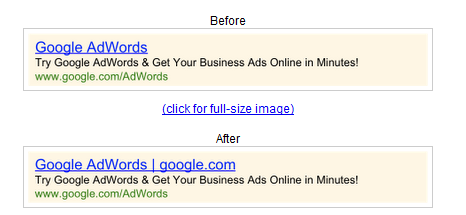If you work in paid search, you know one basic truth: you must always be testing. And that testing includes your test keywords and ad copy.
Search engines, especially Google, must always test too.
Since early this year, Google appears to be putting a lot of emphasis on testing the way ad copy is displayed to users. Why is this important? Ad copy is the one tangible asset in search marketing. It’s transparent, meaning that it can be viewed by your clients and consumers. In contrast, keywords, destination URLs, and bids are behind-the-scenes search magic.
So what has changed this year and what is being tested?
On Jan. 10, Google announced the removal of capitalization in the root destination URL.
So:
- Subdomain.Example.com/Subdirectory
would appear as:
- subdomain.example.com/Subdirectory
On Feb. 3, Google announced longer headlines in ads. In the beta test, the first line of ad copy was automatically moved up to the first line to appear adjacent to the title.

Then just a couple weeks ago, Google announced it was moving the destination URL in line with the ad copy’s title. The thought is you don’t have to include your brand name and take up additional characters in the title to claim “Official site,” or other brand messages.

This week, we also noticed the example, below, where ad copy is actually rolled right into the destination URL. We feel like this is an error in the system, and not an official beta (still unconfirmed either way by Google). However, it demonstrates the system’s flexibility and Google’s interest in continuing to test.

So what does it all mean?
We’ve heard positive feedback from consumers. The consumability of messages has improved. This is important because as ad copy changes on the fly, grabbing a consumer’s attention becomes more difficult.
What impact are these beta releases having on advertisers? The tests did coincide with some (unsustained) CTR fluctuations. However, these fluctuations could just as easily be attributed to our optimization and account goals, as well as the variance in the AdWords betas.

Google appears to be testing as many new combinations as possible at various positions. In the “car insurance” example, below, you can see both the URL in the title as well as the first description line.

As it stands today with these beta tests, there is no way to know the number of times or when your ad appears. So it is incredibly difficult to write ad copy that takes advantage of these tests or understand their impact.
Given these limitations, it’s important to use the ad preview tool to see how your ad appears. Does it make sense and read correctly? We are writing a lot of our ads to be complete sentences in description line one versus allowing the sentence to carry over into description line two.
Don’t let these obstacles stop you from testing your ad copy. There will always be noise in the system. Your awareness and response to this noise will sets you apart from competitors.




